Methods of diagnosing and treating particular causal components of chronic pain in a patient
a patient and causal component technology, applied in the field of medical diagnostics and treatment, can solve the problems of unfavorable patient treatment, unfavorable patient care, and increased economic burden and achieve the effects of reducing the patient's chronic pain, accurately assessing and documenting the level of chronic pain in a patient, and reducing the cost of chronic pain due to direct medical treatmen
- Summary
- Abstract
- Description
- Claims
- Application Information
AI Technical Summary
Benefits of technology
Problems solved by technology
Method used
Image
Examples
examples
[0130]The following non-limiting examples are provided to further illustrate aspects of the invention disclosed herein. It should be appreciated by those of skill in the art that the techniques disclosed in the examples that follow represent approaches that have been found to function well in the practice of the invention, and thus may be considered to constitute examples of modes for its practice. However, those of skill in the art should, in light of the present disclosure, appreciate that many changes may be made in the specific aspects that are disclosed and still obtain a like or similar result without departing from the spirit and scope of the invention.
Example: Method to Analyze and Quantify Biomarkers
[0131]Individual biomarkers may be characterized by mass-to-charge ratio as determined by mass spectrometric techniques including triple quadrupole mass spectrometry (QQQ-MS), Time of flight mass spectrometry (TOF-MS) and single quadrupole mass spectrometry (Q-MS). Biomarkers ma...
PUM
| Property | Measurement | Unit |
|---|---|---|
| oxidative stress | aaaaa | aaaaa |
| blood pressure | aaaaa | aaaaa |
| resting blood pressure | aaaaa | aaaaa |
Abstract
Description
Claims
Application Information
 Login to View More
Login to View More - R&D
- Intellectual Property
- Life Sciences
- Materials
- Tech Scout
- Unparalleled Data Quality
- Higher Quality Content
- 60% Fewer Hallucinations
Browse by: Latest US Patents, China's latest patents, Technical Efficacy Thesaurus, Application Domain, Technology Topic, Popular Technical Reports.
© 2025 PatSnap. All rights reserved.Legal|Privacy policy|Modern Slavery Act Transparency Statement|Sitemap|About US| Contact US: help@patsnap.com



